On the Street
The Drawing Matter editors have been enjoying Eddie Heathcote’s On the Street: In-Between Architecture and wanted to share the following short extracts.
Draining
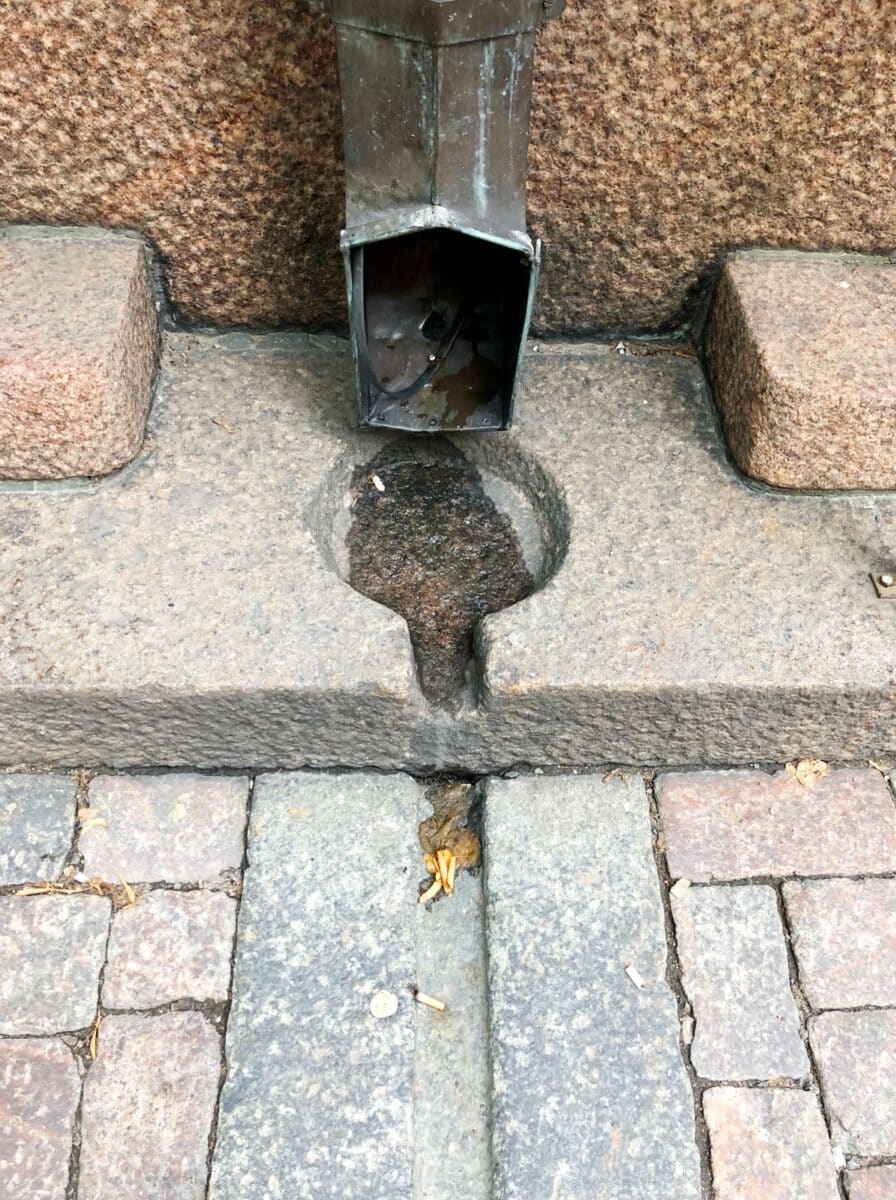
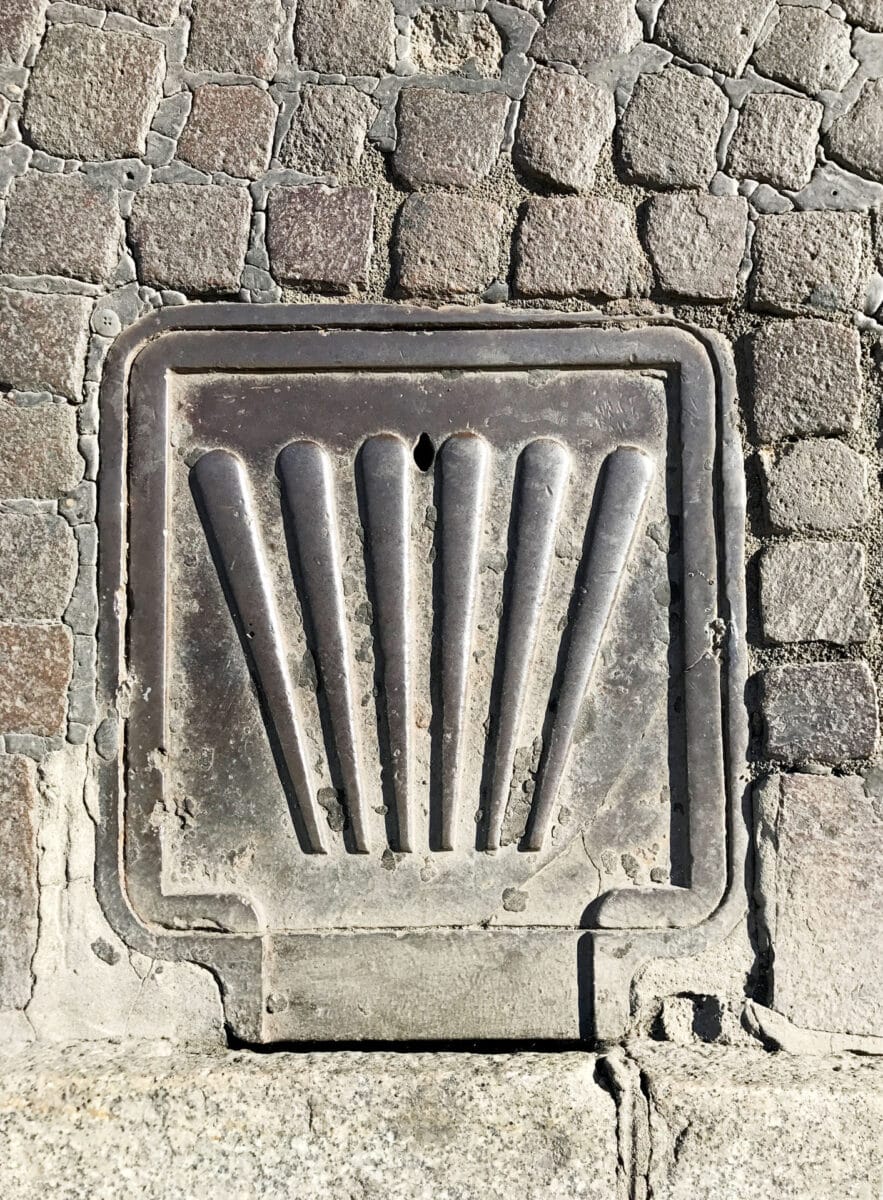
Against the wall under the portico of the church of Santa Maria in Cosmedin in Rome is a strange object, looking a little like a pancake with a face or one of those camembert man-in-the-moon images George Méliès used to conjure for early cinema. Christened the Bocca di Verita (the mouth of truth), the disk is thought to be a Roman drain cover, possibly from the Temple of Venus. It might have drained rainwater from the open oculus in the ceiling or even, perhaps, the blood of ritually slaughtered bulls. The legend is that if a liar puts their hand in the mouth it will close shut permanently, hand and all. Its most famous outing was in the film Roman Holiday in which Gregory Peck’s photographer joshes with Audrey Hepburn’s naive princess by pretending his hand has been trapped. There is a famous image of Hitchcock solemnly sticking his hand in, and another of Brigitte Bardot doing it a little less seriously.
In the film of Stephen King’s It, the sinister clown Pennywise appears behind the grate of a storm drain (inspired, apparently, by a drain in King’s hometown, Bangor in Maine). Things, including paper boats and arms, disappear down the drain. There is, it seems, something innately terrifying about drains. As street furniture goes they are without doubt the most banal items, but perhaps it is the mystery of what goes on below the streets that gives them this aura of other-worldliness. Whatever it is, they are also probably the longest-lived and least changed items of streetware. In Rome today, amid the ruins but even, on occasion, in the working streets, you can come across paving stones with pierced patterns, sometimes simple slots, sometimes a grid of circular holes. They are Ancient Roman drain grates. More elaborate and impressive versions can be seen in museums, such as that from Bothwellhaugh Fort in Lanarkshire (now in Glasgow’s Hunterian Museum) with a six-petalled flower carved into its centre and a chevron rope ring carved around it.
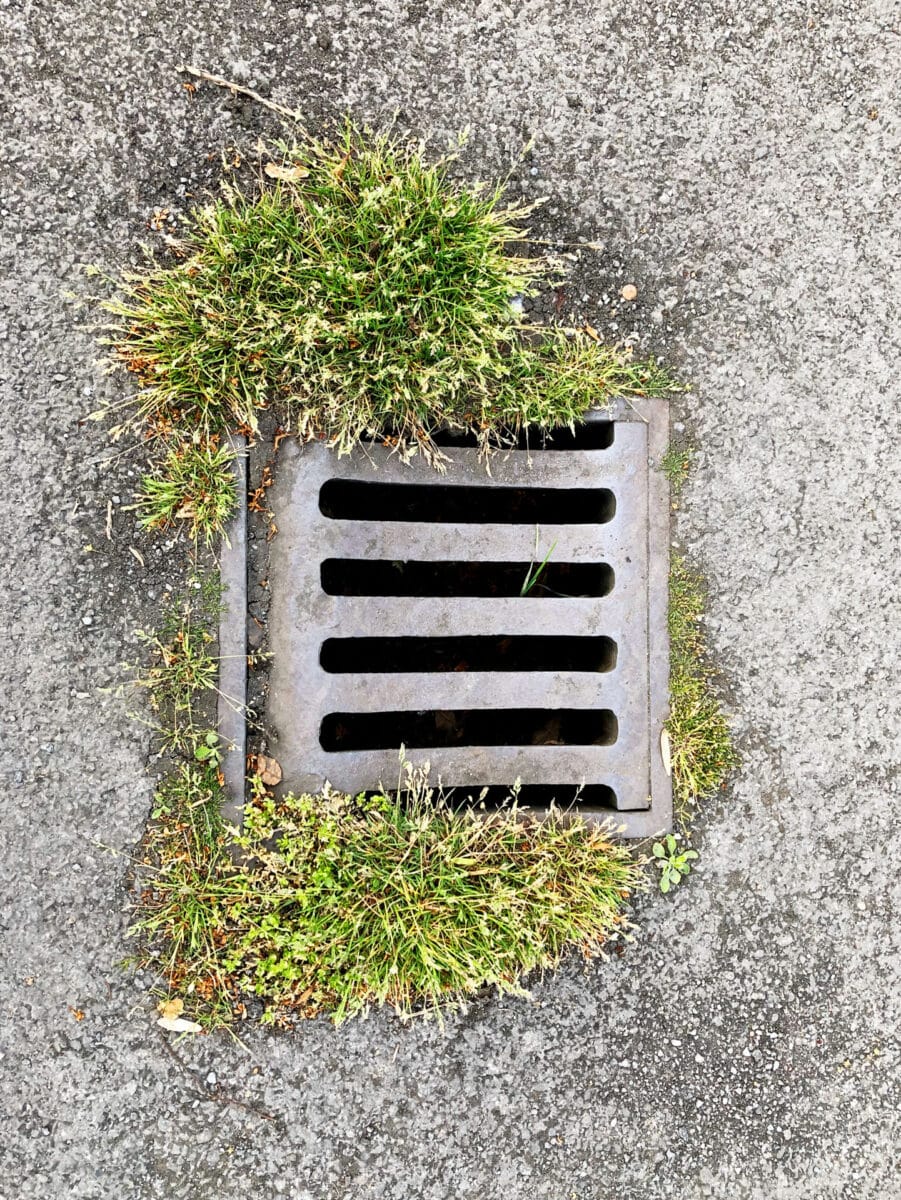
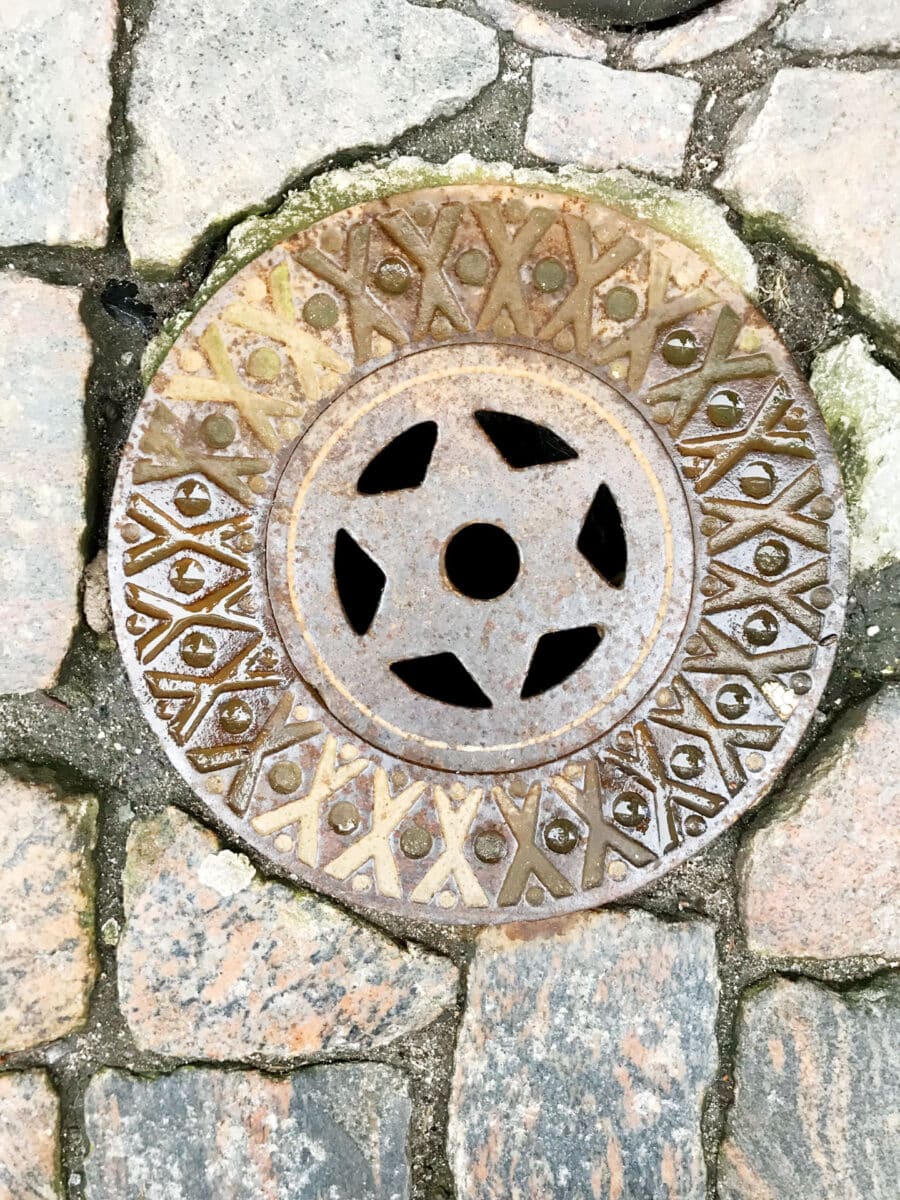
Few pieces of street furniture, excepting perhaps bollards, survive so well and with their design and purpose so unchanged. The main difference is material. Stone gave way to cast iron during the industrial revolution. Slots and grids remain the language of the grate. Thanks to their smartphone-sized openings, slots now seem to be giving way to grids with smaller, square holes, but otherwise designs have remained the same. When the architect Adolf Loos designed his now-revered Michaelerhaus on Vienna’s Michaelerplatz (1909–11), a contemporary cartoonist parodied the building’s unadorned grid of windows by depicting the architect peering into a drain with an iron-grid grate, getting his inspiration from the sewers. The drain cover is the great survivor, suggesting a place where you might always be able to lose something.
Imposing
There are streetlights designed to light the street but there are also massive lamps intended as urban sculpture, as something in between street furniture and a monument, something that aspires to architecture.
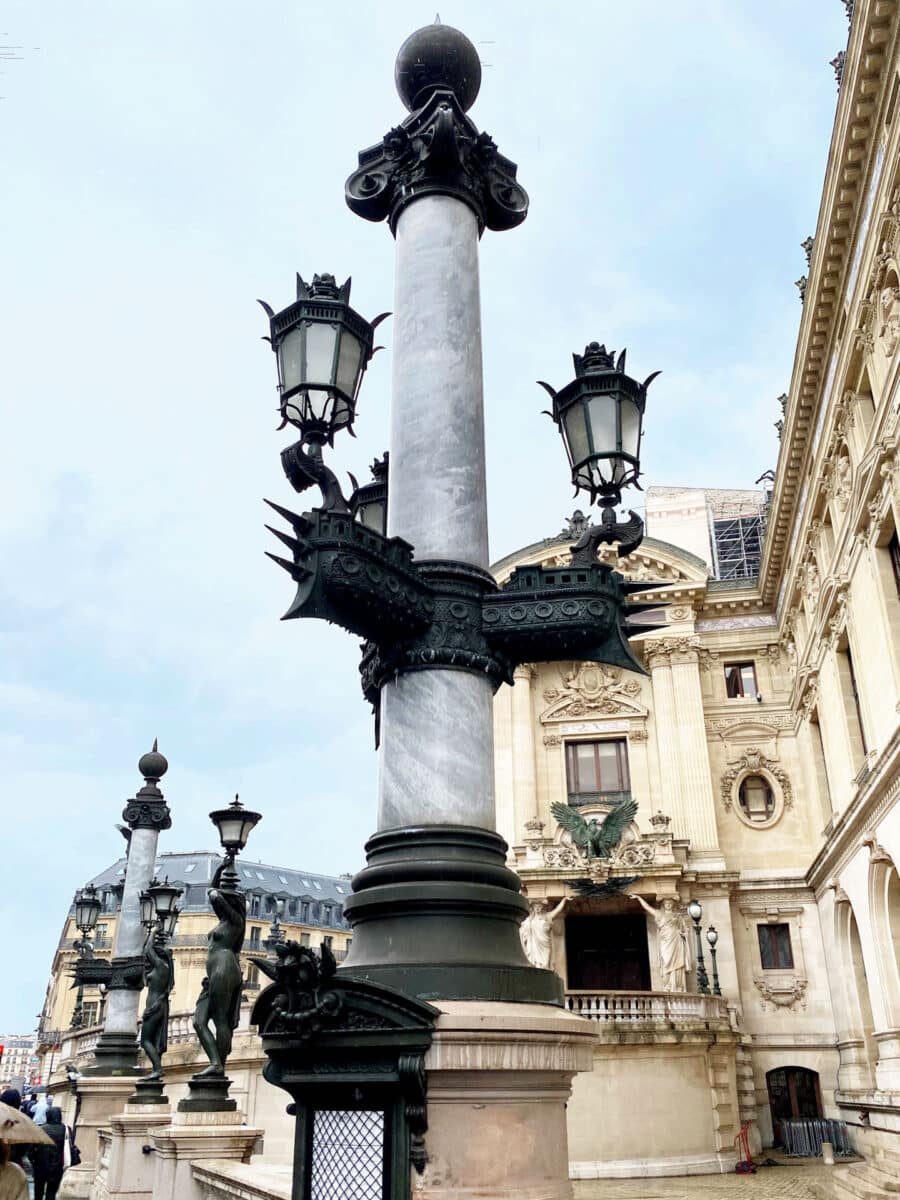


These monumental lamps create a new layer to express a hierarchy of space. Huge space needs huge lamps, objects of mass and substance able to stand their ground in the representational places of the city. The best are in Paris: the lamps, for instance, outside the Opera, where an array of excessive designs marks the zenith of urban aggrandisement. The Opera, or Palais Garnier (named after its architect Charles Garnier) was the apex of the theatrical city plan and, not incidentally, the place where Yablochkoff candles, the brilliant arclights which were the first form of electric streetlighting in the city, were first installed. These lamps had to compete with the elaborate architecture of the opera, to express something of the wonder of the new technology and to celebrate and encapsulate the City of Light and its new public space. They needed to become the external expression of the brilliant chandeliers and footlights inside, the essence of artifice embodied in the Opera as Gesamtkunstwerk.
The results can be quite mad. The most extreme examples merge with the architecture, their shafts stone (not cast iron) columns. With noticeboards for programmes built into their bases and dark iron capitals crowning them, they feature three galleon beakheads with vicious-looking spikes (presumably for ramming other warships), on top of which are balanced spiky-topped glass lanterns. Besides these are nude female figures cast in bronze carrying lanterns on their heads. As you get further away from the Opera, the lights get toned down a little but remain extravagant, their delicately cast forms still featuring galleons and crests until, finally, a few more steps away, the lamps become a little more restrained. These are the versions captured by photographer Charles Marville in his documenting of the new city street furniture in the 1870s (see p.78).
The same motifs appear again in the Place de la Concorde. The vast architectural inventions here, in which the lamps seem to be little more than an afterthought, were designed by Jacques-Ignace Hittorff, architect of the Gare du Nord. Exquisitely cast in bronze with incredible details of acanthus leaves and sea horses, gilded and painted, these too feature those galleon beakheads, here rendered in gold. Outside the Hôtel de la Marine, once the HQ of the French Navy, they make a little more sense here than at the Opera, but the whole design is worthy of a little consideration.
At the centre of the Place de la Concorde is the Obelisk of Luxor, one of two needles which stood outside the Temple of Luxor (the other one is still there) – a gift to the French of Muhammad Ali Pasha in 1830. In its erection in Paris’s most ceremonial square, the city is representing itself as a successor to the great empires of classical civilisation. The streetlamps then had to somehow embody the grandeur of those civilisations. Hittorff chose Rome rather than Luxor (after all, the Romans had subsumed the Egyptian Empire); his design features a fluted column with a composite capital with a sculpted head (looking a little like that of the Statue of Liberty, or arguably, late Elvis) at the centre of each face. Atop is a ball wrapped with a golden band and a spike on top of that. The spike seems to predict, rather uncomfortably, the German Pickelhaube, the spiked helmet worn by German soldiers who would later humiliate the French in the war of 1870. The ball represents, surely, the world and French connections and culture spanning the equator, embracing the globe. The galleons, sea horses and shells represent the seas, the acanthus, oak and laurel leaves the land, and an anchor appears, if you look long enough, between the two lamp brackets.
It merges the form of the rostral column (the Roman moment of victory) on which Rome would display the captured beaks of captured warships with a streetlight, the form for which was still emerging. It has a lot of work to do which, presumably, is why it also needs to be expressed as a column. If street furniture is a language of objects which exists between architecture and pedestrians, this is a rarefied world of things mediating between the various scales of the monumental, between the statues and fountains, the porticoes and flagpoles. They can seem beautiful or, in another mood, wonderfully ridiculous.
Praying
The cocktail kitsch of Rococo, Baroque and church-porch souvenirs that are the madonelle are among the most eye-catching features of a walk through the backstreets of any Italian city. They might be Rococo aedicules framing painted Madonnas, mosaic Marys in roundels, or elaborate Baroque angels flanking a serene figure with a filigree copper or cast-iron and zinc roof to protect them from the rain. Or they might be little figurines in old glass vitrines – plaster virgins with fairy-light halos and faded fake flowers, or plastic Madonnas arranged with sea shells and red glass candle holders in holes-in-the-wall. The weak glow of a fairy-lit virgin in a dark alley is both a warming and a slightly unsettling sight. They are the most public affirmations of Catholicism in the secular townscape, but they are simultaneously strangely pagan in their origins and their affect.

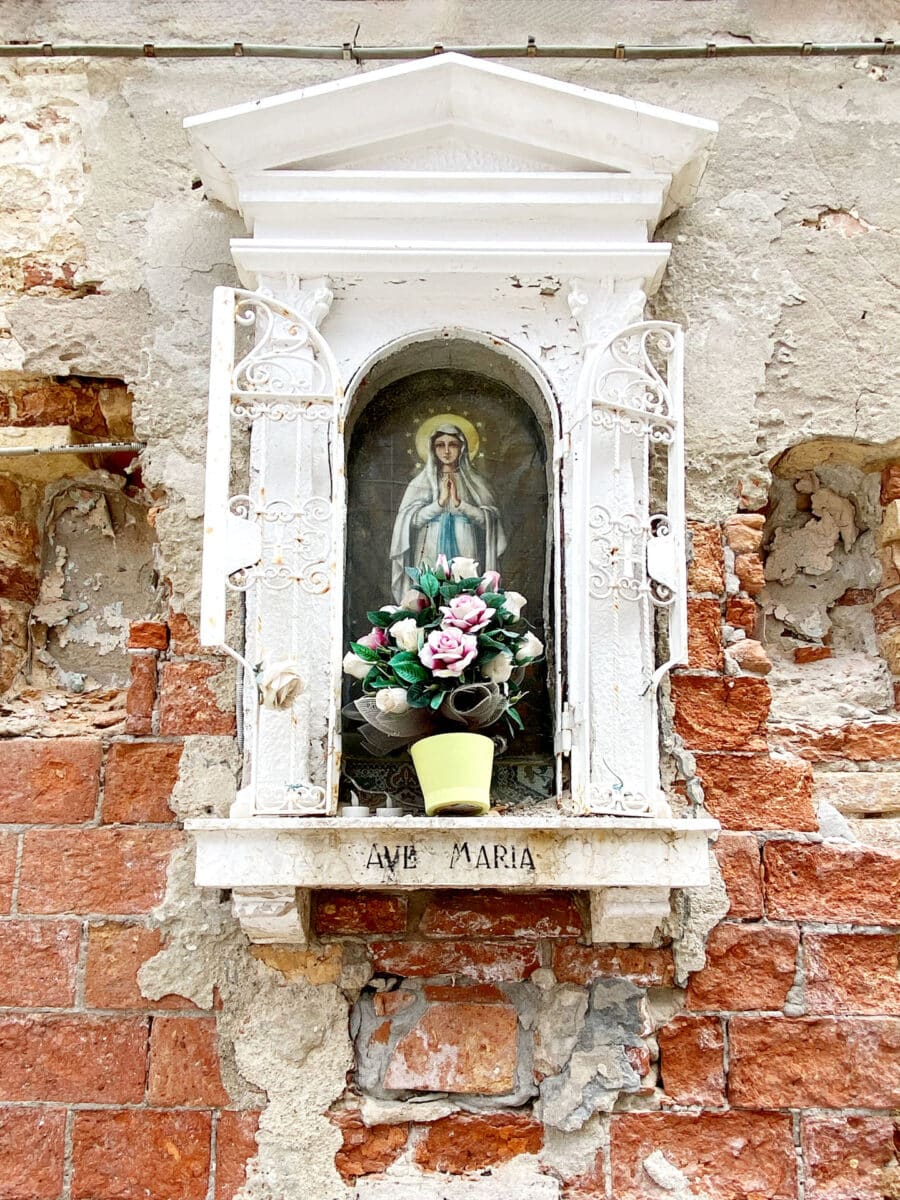

They evolved, it seems, from the Roman tradition of shrines to the Lares, gods of good fortune, which were placed in homes or at crossroads to bring safety to those who prayed to them. Crossroads have always been seen as places of danger or demons, potential wrong roads taken, presided over by evil spirits. It is a tradition which survives from the classical world: the Greeks had Hermes and Hecates, guardians of the crossroads which were seen as liminal zones, uncertain places fraught with danger; offerings and sacrifices were made to appease the gods. Perhaps those customs carried through into Northern European traditions, in which gallows were erected at crossroads. Bodies were left to rot above them and suicides buried beneath them – the idea was that any ghosts would be lost, uncertain where to go, remaining stranded at the junction. In African American hoodoo, similar myths about crossroads appear to have survived from Kongo culture.

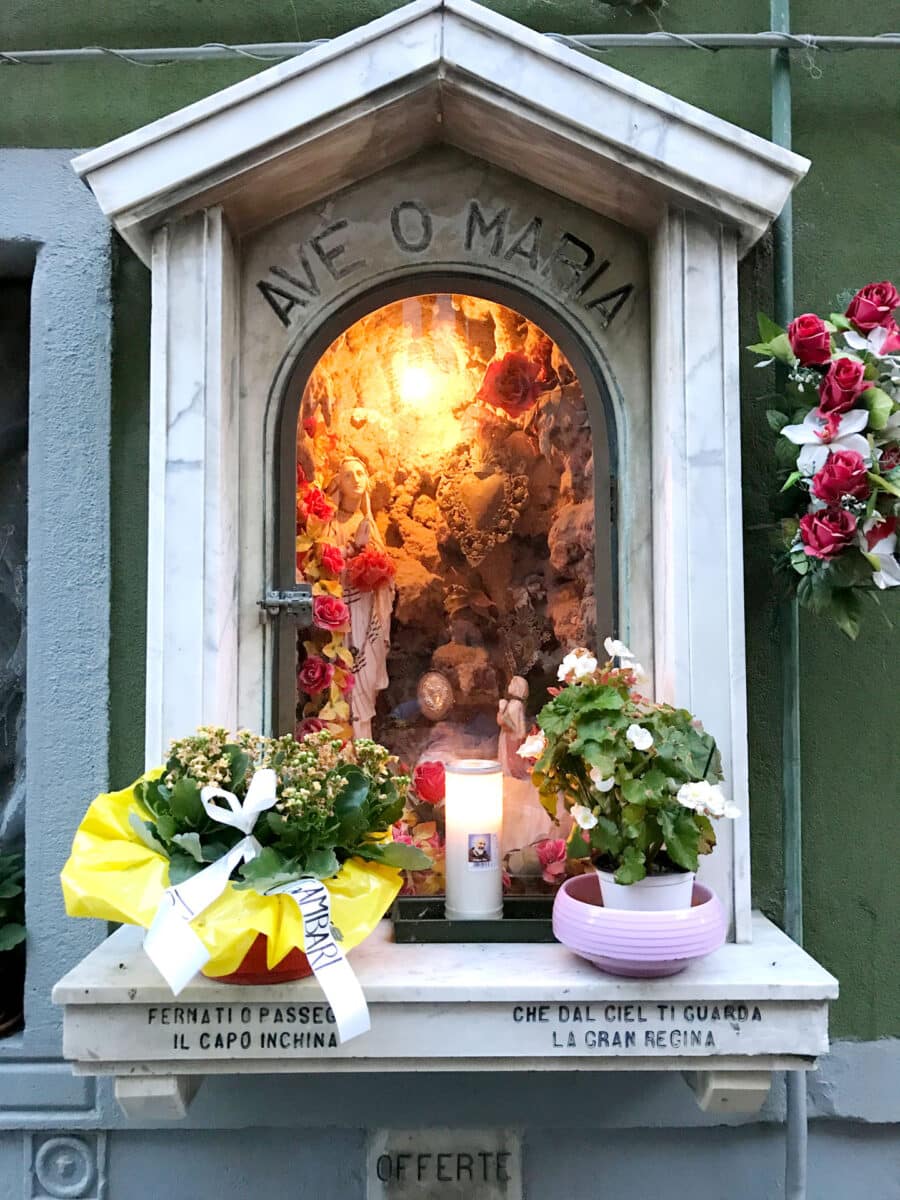
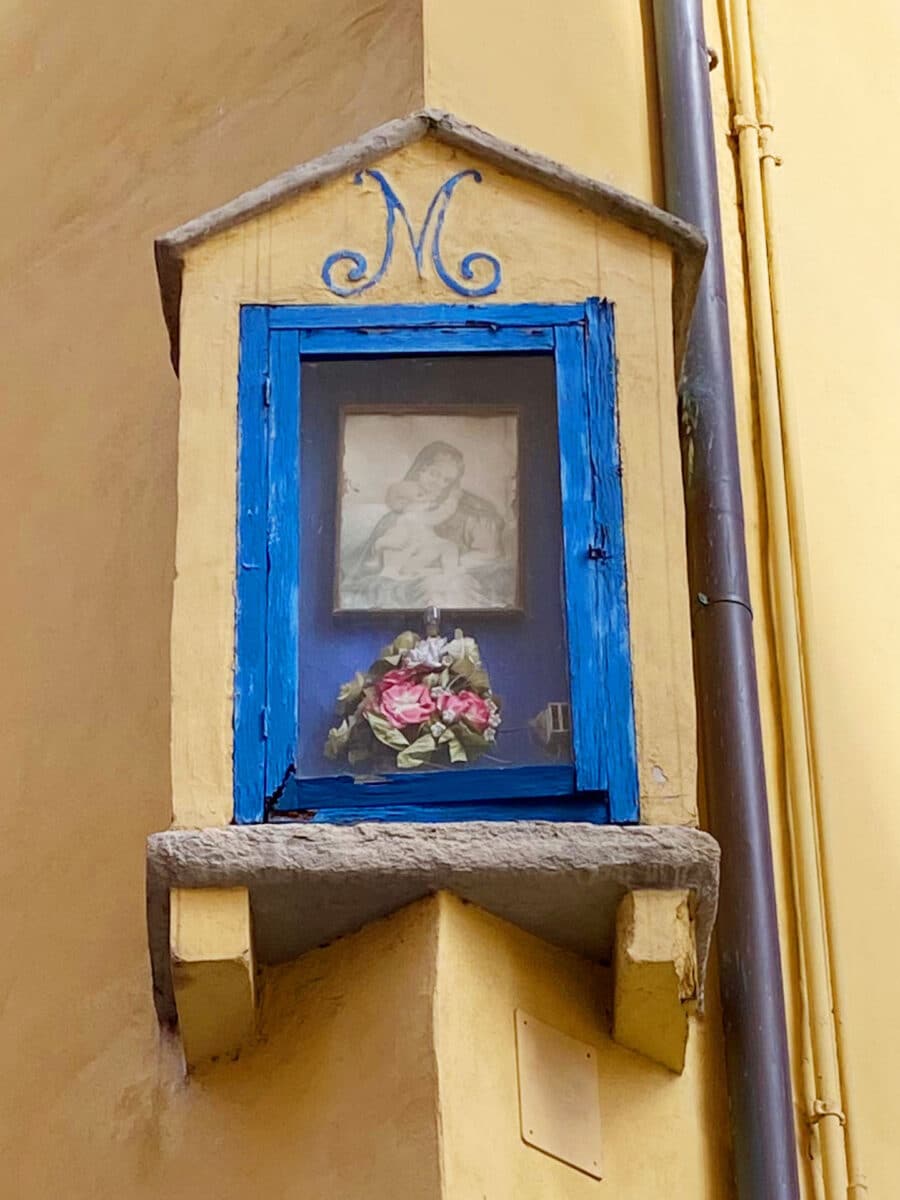
The Italian madonelle (there are similar versions elsewhere in Europe, notably France) embody all these anxieties, but they are also an attempt to inscribe sanctity into the city with the very practical side-effect of becoming an early form of streetlighting, urban way-finding and the expression of local identity and piety. Candles and votive lamps placed in the shrines or around them (some even had wrought-iron candle holders and lanterns) subtly lit dark streets with tiny points of light, enough for orientation. Coming across a lit shrine in the dingy, misty winter alleys of Venice still gives a little thrill, a sense that you are not entirely alone in a seemingly deserted city. Just occasionally they might appear above a vitrine, a showcase for a nearby store. I noticed one such juxtaposition in Florence, a very particular mix of consumption and devotion.


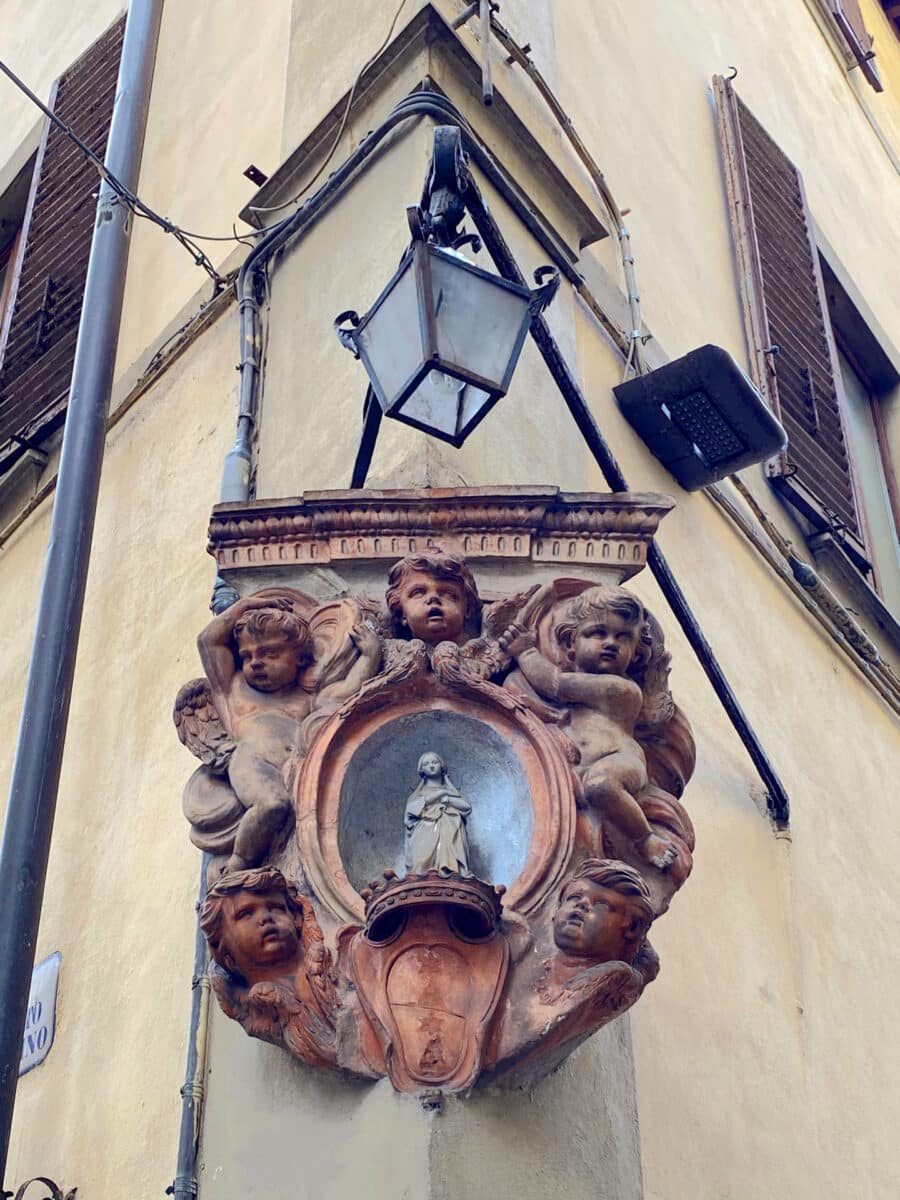
With some of the shrines behind glass, others in aedicular structures like miniature temples, there is an impression of the doll’s house or even the miniature theatre. Like the votive disembodied body parts which stud the velvet panels of southern Spanish or Mexican churches, there is a drama, a foot-lit glow. Even the most modern of the madonelle, with their cheap plastic statues and strings of One Euro store lights, exude something ancient, a curious mix of intrigue and discomfort. These shrines still do their job, to remind the walker that dark streets are not always safe, in the city you are never alone, and that it is always good to say a little prayer and perhaps cross yourself, just in case.
All images courtesy of Edwin Heathcote.
Edwin Heathcote is the architecture and design critic of The Financial Times. He is author of about a dozen books including The Meaning of Home and is an architect and designer. Heathcote is also the Keeper of Meaning at The Cosmic House in London as well as the founder and editor of the online design writing archive readingdesign.org. He lives in London.
